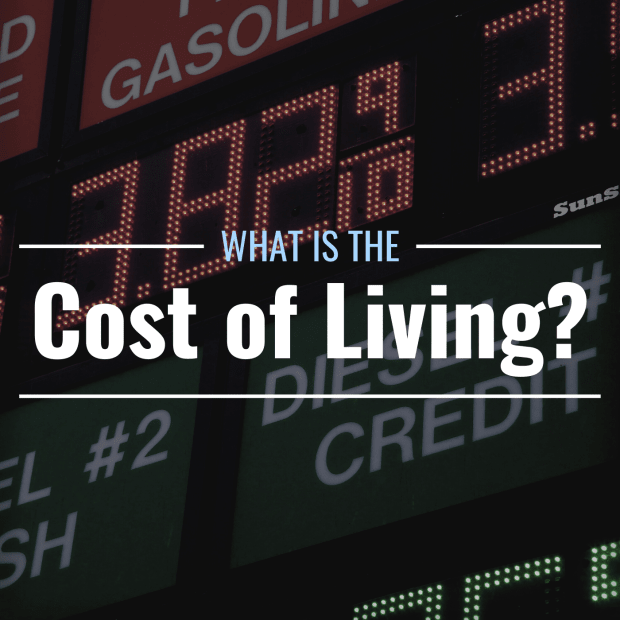
What Does “Cost of Living” Mean?
Cost of living refers to the amount of income required to maintain a certain lifestyle in a certain place at a certain point in time. Cost of living varies geographically and temporally, meaning that the same lifestyle often costs different amounts in different regions, and in any particular region, that cost can go up (or, in rare cases, down) over time.
For instance, let’s say an individual could maintain a basic but comfortable lifestyle—including a modest apartment, healthcare, food, public transportation, and enough extra money to contribute to savings and go out a few times a month—on an annual income of $39,000 in Town A, a medium-sized suburb. In Town B, a more densely populated metropolitan area, this same lifestyle might require an annual income of $49,000 because rent, food, and other expenses are higher there. In this case, the cost of living is substantially higher in Town B than in Town A.
Another way to think about cost of living is to compare what you could get for a certain salary in one place vs. another. For instance, an annual income of $85,000 in Fort Wayne, Indiana, might afford an average citizen plenty of leftover money after things like housing food, and taxes are taken care of. In Manhattan, New York, on the other hand, this same income might barely cover necessities and leave little remaining for discretionary purchases. This is because goods and services—including necessities like rent and food—cost substantially more on average in Manhattan than in Fort Wayne.
Because the cost of living varies across the United States, wages and salaries are higher in places where things like rent, food, and gas cost more. For this reason, similar jobs may pay different amounts in different places.
What Is a Cost of Living Index?
A cost of living index is a handy tool that can be used to compare the cost of living between states (or cities) by assigning each one a simple number that represents the aggregate average cost of a hypothetical basket of the goods and services that most folks would need to purchase in order to live in any city (e.g., rent, groceries, healthcare, childcare, taxes, etc.). Most indexes use 100 as a base number. This base number is usually associated with a city or region that falls somewhere near the average or median cost of living of all of the regions sampled by the index.
Thus, a region with an index score of 84 would be 26% cheaper to live in than the base region, and one with a score of 112 would be 12% more expensive. An individual considering moving from one city to another could compare their city’s index score to their target city’s index score to find out approximately how much cheaper (or more expensive) it would be to live there.
How Can You Use a Cost-of-Living Index to Compare Regions?
If you want to use cost-of-living index data to figure out how much you would need to make to maintain your current lifestyle in another place, you can use the following formula:
Income Change = (City B – City A) / City A
Note: City A is where you currently live, and City B is where you are considering moving.
Let’s say you currently live in Colorado Springs, Colorado, and are considering moving to San Francisco, California. Numbeo’s cost-of-living index gives Colorado Springs a 75.77 and San Francisco a 95.78.
Income Change = (City B – City A) / City A
Income Change = (95.78 – 75.77) / 75.77
Income Change = (20.01) / 75.77
Income Change = 0.2641 = 26.41%
So, if you moved to San Francisco from Colorado springs, your income would need to go up by 26.41% if you wanted to maintain your current lifestyle.
What Is a Cost-of-Living Calculator?
If you prefer not to use index data to manually calculate how much your salary might need to change if you moved, there are several easy-to-use calculators available for free online from the following companies:
Simply enter your current city, your target city, and your annual income, and these calculators can tell you how much more (or less) you’d need to make in order to maintain your current lifestyle.
What Is a Cost-of-Living Adjustment (COLA)?
Inflation is more common than deflation, and it causes the prices of necessities—like food, rent, and transportation—to rise. A cost-of-living adjustment, or COLA, is an increase in wages, salaries, benefits, or other forms of compensation to keep up with changes in the actual costs of living due to inflation.
For example, each year, the Social Security Administration examines whether to increase benefits via a COLA. They make their decision based on changes in the Consumer Price Index, one of the most popular tools used to measure inflation. In 2021, SSA increased benefits by 1.3 percent, and in 2022, when inflation rose at a higher-than-usual pace, it increased benefits by a whopping 5.9 percent.
While not required to, many employers also conduct wage reviews and provide cost-of-living adjustments (separate from performance-based raises) annually or periodically to help their employees keep up with inflation.
Which U.S. Cities Have the Highest Cost of Living?
The following are the five most expensive cities to live in in the United States:
- New York City, New York
- San Francisco, California
- Honolulu, Hawaii
- Boston, Massachusetts
- Washington, D.C.
Which U.S. Cities Have the Lowest Cost of Living?
The following are the five cheapest major cities to live in in the United States:
- El Paso, Texas
- Wichita, Kansas
- Lexington, Kentucky
- Little Rock, Arkansas
- Tulsa, Oklahoma
Will the Cost of Living Continue to Rise?
While rapid inflation has driven the cost of living up at an alarming rate this year, TheStreet’s Ellen Chang cites many economists’ claims that inflation has already begun to slow.







